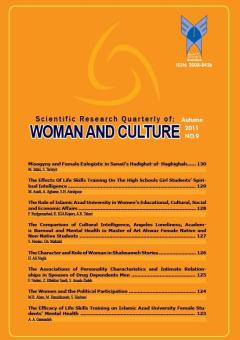The Comparison of Cultural Intelligence, Angeles Loneliness, Academic Burnout and Mental Health in Master of Art Ahwaz Female Native and Non-Native Students
Subject Areas : Religion and jurisprudenceسکینه Heidari 1 * , Gh. H. Maktabi 2
1 - Instructor of Payam Noor University, Goutvand Branch, MA in Educational Psychology, Goutvand, Iran
2 - Shahid Chamran University, Assistant Professor, Department of Psychology, Ahwaz, Iran
Keywords:
Abstract :
The objective of the present study was comparing cultural intelligence, Angeles loneliness, academic burnout and mental health of the master of art female students in Ahwaz. The population of this study included the native and nonnative female students. The sample of native and nonnative female students consisted of 50 students for each group, who were selected randomly by multi-stage sampling method. Multivariate analysis of variance (MANOVA) was used for the data analyzing. The results revealed that there was significant difference between native and nonnative students’ mental health (and its subscales). Also, Angeles loneliness of the nonnative students was more than that of native students. In addition, academic burnout (and its subscales) of the nonnative students exceeded that of native students. Finally, nonnative students gained higher scores than that of native students in cultural intelligence.
باوی، سعید (1383). رابطه بین خودبیمارانگاری با حمایت اجتماعی در بین زنان و مردان شهرستان اهواز. پایان نامه کارشناسی ارشد روان شناسی عمومی، دانشگاه آزاد اسلامی، واحد اهواز.
پایندان، طیبه (1389). مقایسه تاب آوری، سلامت روان، پرخاشگری و عملکرد تحصیلی دانش آموزان دختر دبیرستانی خانواده های طلاق و عادی شهر اهواز با کنترل وضعیت اجتماعی- اقتصادی. پایانامه کارشناسی ارشد روانشناسی دانشگاه شهید چمران اهواز.
حسینی، حمزه و موسوی، میرحسین (1383). مقایسه وضعیت سلامت روانی دانشجویان کارآموز پزشکی و پیراپزشکی. مجله علمی دانشگاه علوم پژشکی گرگان. سال ششم، شماره 13، 101-107.
حیدرئی، علیرضا، احتشام زاده، پروین، مرعشی، ماندانا(1389) رابطه شدت بی خوابی، کیفیت خواب، خواب آلودگی و اختلال در سلامت روان با عملکرد تحصیلی در دختران، فصلنامه علمی پژوهشی زن و فرهنگ، سال اول، شماره چهارم، ص 76-65.
حیدری خواه، راضیه (1390) مقایسه دانش آموزان دبیرستانی دختر دارای مادران با سبک های فرزندپروری متفاوت از لحاظ دلبستگی به مادر، خودکارآمدی، احساس تنهایی و عملکرد تحصیلی در شهرستان خرم آباد. پایانامه کارشناسی ارشد، دانشگاه شهید چمران اهواز.
رحمانپور، لیلا.(1384). فرایند تیم سازی در سازمانها. ماهنامه علمی - آموزشی تدبیر ، سال 14 ، شماره 131.
سادوک، بنیامین و سادوک، گرب (2007). خلاصه ی روانپزشکی: علوم رفتاری-روانپزشکی بالینی. ترجمه ی فرزین رضاعی (1389). تهران: انتشارات ارجمند.
عباسی زاده، زهرا ( 1389). هوش فرهنگی؛ سازگاری با ناهمگونها. ماهنامه تدبیر.
عندلیب، مازیار (1390). بررسی رابطه بین اضطراب اجتماعی، سبک های دلبستگی، باورهای غیرمنطقی، هوش هیجانی و ابزار وجود با احساس غربت در دانشجویان غیر بومی در دانشجویان غیر بومی دانشگاه شهید چمران. پایانامه ی کارشناسی ارشد، دانشگاه شهیدچمران اهواز.
نعامی، عبد الزهرا (1388). رابطه ی بین کیفیت تجارب یادگیری با فرسودگی تحصیلی دانشجویان کارشناسی ارشد دانشگاه شهید چمران اهواز. مجله ی مطالعات روان شناختی، دوره ی پنجم ، شماره ی سوم، پاییز 1388.
یعقوبی، ابوالقاسم، فرهادی، مهران، قنبری، نیک زاد و کاکابرایی، کیوان (1387). بررسی رابطه هوش هیجانی با احساس غربت و سلامت عمومی دانشجویان. فصلنامه روانشناسی دانشگاه تبریز، سال نهم، شماره 3، 151-135.
Andrews, B., Wilding, J. M. (2004). The relation of depression and anxiety to life-stress and achievement in student. Br Journal Psychol, 95 (4), 509-521.
Benn, L., Harvey. J. E., Gilbert. P., & Irons. C. (2005). Social rank, interpersonal trust and recall ofparental rearing in relation to homesickness. Personality and individual differences. 8(38), 1813-1822.
Breso, E, Salanova, M & Schoufeli, B, (2007). In search of the third dimension of Burnout, Applied psychology, 56 (3), 460-472.
Bruce, S. P. (2009). Recognizing stress and avoiding burnout. Currrents in Pharmacy Teaching and Learning, 1(1), 57-64.
Elhageen, A. M. (2004). Effect of interaction between parental treatment styles and peer relation in classroom on the feeling of lonlineess among deaf children in Egyptian schools. Unpublished M.D Dissertation, Eberhard-Karls- University.
Earley, P.C., & Ang, s. (2003). Cultural Intelligence : indivisual interactions across cultures. Stanford , CA . Stanfors Business Books.
Earley, P.C., & Peterson, S. R. (2004). The elusive cultural chameleon : “cultural intelligence as a new Approache to intercultural training for the global manager”. Academy of Management Learning and Education , 27 (3) ,76 – 84.
Kreutz, G., Ginsborg, J. & Williamon, A. (2009). Health-promoting behaviours in
conservatoire students. Higher Education Research and Development, 26 (1) ,47 – 60.
Mendersheid, R., Ryff, C., Freeman, E., Mckinight. R., Dhingra, s., & Strine, T. (2010). Evolving definitions of mental illness and wellness. Preventing Chronic Disease, 7, 1-6.
Moneta, G. B. (2011). Need for achievement, burnout, and intention to leave: Testing an occupational model in educational settings. Personality and Individual Differences, 50(2), 274-278
Retteck., S.L. (2003). The mental health of student in higher Education. Journal of Psychology. 5(4), 80-89.
Salmela-Aro, K., & Naatanen, P. (2005). PPI: Nuorten kouluuupumus-mentelma. Adolescenta school burnout method, Helsinki, Finland, Edita.
Toppinen-Tanner, S., Ojaarvi, A., Vaananen, A., Kalimo, R., & Jappinen, P. (2005). Burnout as a predictor of medically certified sick-leave absences and their diagnosed causes. Behavioral Medicine, 31, 18-27.
Zhang, Y., Gan, Y., & Cham, H. (2007). Perfectionism, academic burnout and engagement among Chinese college students: A structural equation modeling analysis. Personality & Individual Differences, 43(6), 1529-1540.
_||_
